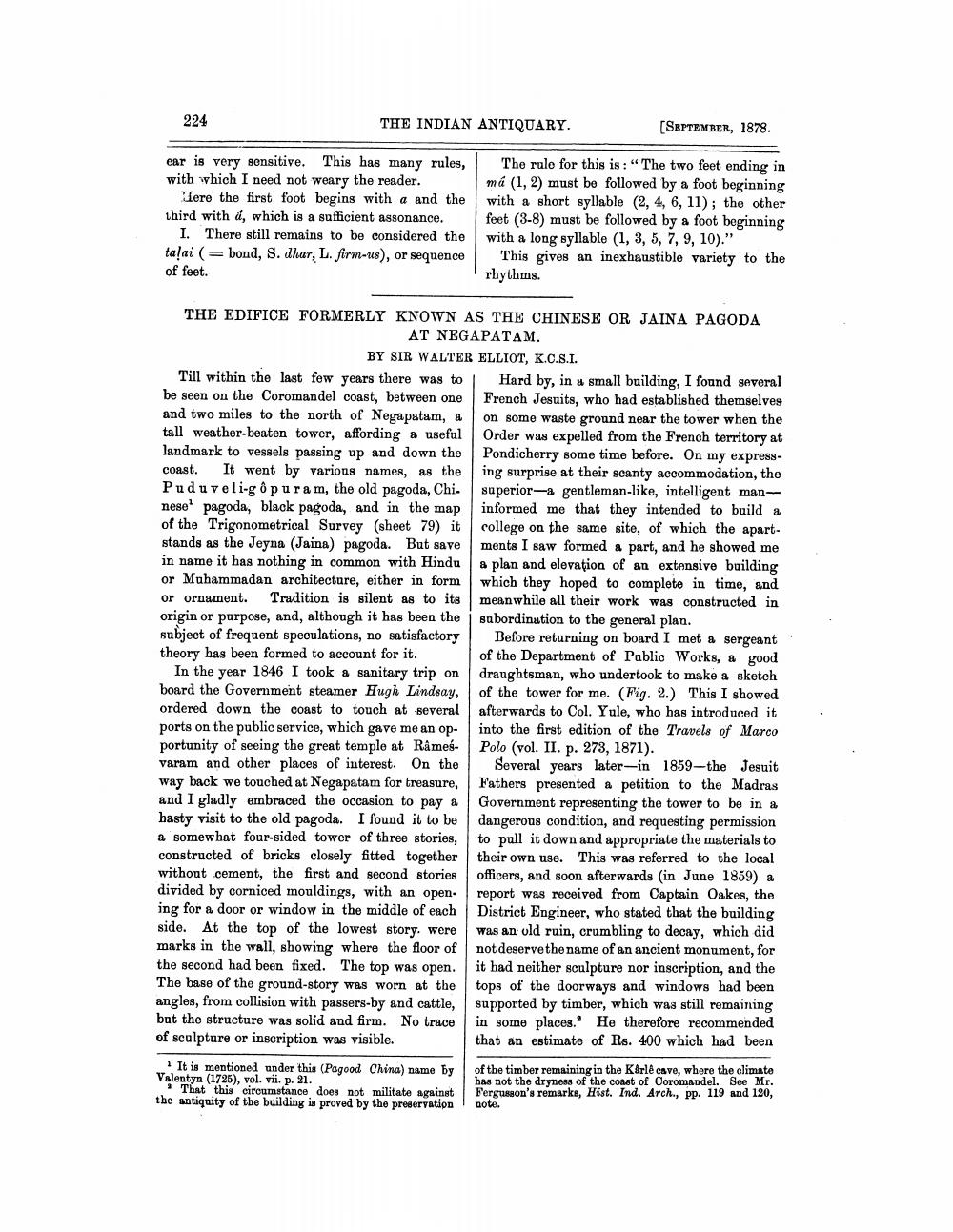________________
224
THE INDIAN ANTIQUARY.
(SEPTEMBER, 1878.
ear is very sensitive. This has many rules, with which I need not weary the reader.
Here the first foot begins with a and the third with d, which is a sufficient assonance.
1. There still remains to be considered the talai (=bond, S. dhar, L. firm-us), or sequence of feet.
The rulo for this is: “The two feet ending in má (1, 2) must be followed by a foot beginning with a short syllable (2, 4, 6, 11); the other feet (3-8) must be followed by a foot beginning with a long syllable (1, 3, 5, 7, 9, 10)."
This gives an inexhaustible variety to the rhythms.
THE EDIFICE FORMERLY KNOWN AS THE CHINESE OR JAINA PAGODA
AT NEGAPATAM.
BY SIR WALTER ELLIOT, K.C.S.I. Till within the last few years there was to Hard by, in a small building, I found several be seen on the Coromandel coast, between one French Jesuits, who had established themselves and two miles to the north of Negapatam, a on some waste ground near the tower when the tall weather-beaten tower, affording a useful Order was expelled from the French territory at landmark to vessels passing up and down the Pondicherry some time before. On my expresscoast. It went by various names, as the ing surprise at their scanty accommodation, the Pudu veli-gopuram, the old pagoda, Chi- superior-a gentleman-like, intelligent mannesel pagoda, black pagoda, and in the map informed me that they intended to build a of the Trigonometrical Survey (sheet 79) it college on the same site, of which the apartstands as the Jeyna (Jaina) pagoda. But save ments I saw formed a part, and he showed me in name it has nothing in common with Hindu a plan and elevation of an extensive building or Muhammadan architecture, either in form which they hoped to complete in time, and or ornament. Tradition is silent as to its meanwhile all their work was constructed in origin or purpose, and, although it has been the subordination to the general plan. subject of frequent speculations, no satisfactory Before returning on board I met a sergeant theory has been formed to account for it. of the Department of Pablic Works, & good
In the year 1846 I took a sanitary trip on draughtsman, who undertook to make a sketch board the Government steamer Hugh Lindsay, of the tower for me. (Fig. 2.) This I showed ordered down the coast to touch at several afterwards to Col. Yule, who has introduced it ports on the public service, which gave me an op- into the first edition of the Travels of Marco portunity of seeing the great temple at Rames- Polo (vol. II. p. 273, 1871). varam and other places of interest. On the Several years later-in 1859-the Jesuit way back we touched at Negapatam for treasure, Fathers presented a petition to the Madras and I gladly embraced the occasion to pay a Government representing the tower to be in a hasty visit to the old pagoda. I found it to be dangerous condition, and requesting permission a somewhat four-sided tower of three stories, to pull it down and appropriate the materials to constructed of bricks closely fitted together their own use. This was referred to the local without cement, the first and second stories officers, and soon afterwards (in June 1859) a divided by corniced mouldings, with an open. report was received from Captain Oakes, the ing for a door or window in the middle of each District Engineer, who stated that the building side. At the top of the lowest story. were was an old ruin, crumbling to decay, which did marks in the wall, showing where the floor of not deserve the name of an ancient monument, for the second had been fixed. The top was open. it had neither sculpture nor inscription, and the The base of the ground-story was worn at the tops of the doorways and windows had been angles, from collision with passers-by and cattle, supported by timber, which was still remaining but the structure was solid and firm. No trace in some places. He therefore recommended of sculpture or inscription was visible.
that an estimate of Rs. 400 which had been
_ It is mentioned under this (Pagood China) name by 1 of the timber remaining in the
of the timber remaining in the K&rlê cave, where the climate Valentyn (1725), vol. vii. p. 21.
has not the dryness of the coast of Coromandel. See Mr. That this circumstance does not militate against Fergusson's remarks, Hist. Ind. Arch., pp. 119 and 120, the antiquity of the building is proved by the preservation note.




